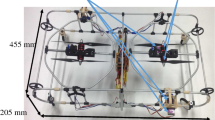Abstract
This paper presents the flight control of coupling both the position and attitude for a tandem rotor UAV robot that has two 2-DOF tiltable coaxial rotors in the presence of wind field disturbance. The performance of the proposed computed torque control strategy showed some limitations considering the wind field disturbances in the previous study, in which the dynamical models of the proposed tandem rotor UAV robot and the model of the wind field disturbances have been discussed. To improve the flight performance of the UAV robot, a classical backstepping controller is designed and the system using this controller is proved to be asymptotically stabilized by the Lyapunov stability theory when not considering the external disturbance. Also, a robust backstepping controller for the UAV robot considering the wind field disturbances is proposed, which includes the integral of error in the Lyapunov function, together with using a saturation function in the controller. Finally, some numerical simulations are demonstrated to verify the performance of the proposed strategies for the UAV robot.







Similar content being viewed by others
Explore related subjects
Discover the latest articles, news and stories from top researchers in related subjects.References
Alotaibi ET, Alqefari SS, Koubaa A (2019) Lsar: Multi-uav collaboration for search and rescue missions. IEEE Access 7:55817–55832
Flener C, Vaaja M, Jaakkola A, Krooks A, Kaartinen H, Kukko A, Kasvi E, Hyyppa H, Hyyppa J, Alho P (2013) Seamless mapping of river channels at high resolution using mobile LiDAR and UAV-photography. Remote Sens 5(12):6382–6407
Nikolic J, Burri M, Rehder J, Leutenegger S, Huerzeler C, Siegwart R (2013) A UAV system for inspection of industrial facilities. In: Aerospace conference, 2013 IEEE, pp 1–8
Bouabdallah S, Siegwart R (2007) Full control of a quadrotor. In: IEEE/RSJ international conference on intelligent robots and systems, 2007, IROS 2007, San Diego, CA, USA, pp 153–158
Rashad R, Goerres J, Aarts RG, Engelen JB, Stramigioli S (2020) Fully actuated multirotor UAVs: a literature review. IEEE Robot Autom Mag 27(3):97–107
Kastelan D, Konz M, Rudolph J (2015) Fully actuated tricopter with pilot-supporting control. IFAC-PapersOnLine 48(9):79–84
Xu X, Watanabe K, Nagai I (2020) Feedback linearization control for a tandem rotor UAV robot equipped with two 2-DOF tiltable coaxial-rotors. Artif Life Robot. https://doi.org/10.1007/s10015-020-00655-x
Zhou L, Zhang J, She H, Jin H (2019) Quadrotor UAV flight control via a novel saturation integral backstepping controller. Automatika 60(2):193–206
Xu X, Watanabe K, Nagai I (2018) Development of an aerial robot that has multifunctional locomotion modes with tilted coaxial rotors. In: Proceedings of 2018 37th Chinese control conference (CCC), Wuhan, pp 7896–7900
Li B, Wang D, Ma L (2019) BioTetra: a bioinspired multi-rotor aerial vehicle. In: Proceedings of IEEE international conference on robotics and biomimetics (ROBIO), Dali, China, pp 114–119
Li YX, Yang GH (2016) Fuzzy adaptive output feedback faulttolerant tracking control of a class of uncertain nonlinear systems with nonaffine nonlinear faults. IEEE Trans Fuzzy Syst 24(1):223–234
Abichandani P, Lobo D, Ford G, Bucci D, Kam M (2020) Wind measurement and simulation techniques in multi-rotor small unmanned aerial vehicles. IEEE Access 8:54910–54927. https://doi.org/10.1109/ACCESS.2020.2977693
Author information
Authors and Affiliations
Corresponding author
Additional information
Publisher's Note
Springer Nature remains neutral with regard to jurisdictional claims in published maps and institutional affiliations.
This work was presented in part at the 26th International Symposium on Artificial Life and Robotics (Online, January 21–23, 2021).
About this article
Cite this article
Xu, X., Watanabe, K. & Nagai, I. Flight control system design for a tandem rotor UAV robot in the presence of wind field disturbances. Artif Life Robotics 26, 457–464 (2021). https://doi.org/10.1007/s10015-021-00704-z
Received:
Accepted:
Published:
Issue Date:
DOI: https://doi.org/10.1007/s10015-021-00704-z




